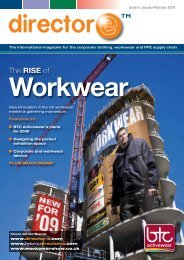Official Show Guide - director-e
Official Show Guide - director-e
Official Show Guide - director-e
You also want an ePaper? Increase the reach of your titles
YUMPU automatically turns print PDFs into web optimized ePapers that Google loves.
PPE<br />
Comfort and performance are the ultimate priorities when it<br />
comes to protective clothing but, as no one wants to wear a highvis<br />
bin liner, we include small but practical details in our clothing<br />
protection against heat and flames, EN 1149 for<br />
electrostatic recharging, high visibility standard<br />
EN 471 and has basic protection against liquid<br />
chemicals.<br />
Although existing garments made to EN 531 can<br />
still be produced, sold and used in the market, all<br />
new FR garments developed today must meet the<br />
new standards: EN ISO 11612, which replaces EN<br />
531 for heat and flame protection, and EN ISO<br />
11611, which replaces EN 470-1 for small molten<br />
metal splashes. Praybourne’s new FR range, out in<br />
April, has been tested to the new standards, and<br />
consists of a combat style coverall and trouser<br />
with removable knee pads, combat pockets and<br />
reflective piping. Made from the inherently flame<br />
retardant fibre Protex ® , even the garment’s antistatic<br />
properties are designed to be hardwearing.<br />
“The anti-static fibre is pure steel as opposed to<br />
carbon but this doesn’t mean that it’s rigid,”<br />
Praybourne’s Stuart Jukes says. “It’s very soft to<br />
touch but, because it’s steel, it makes the fabric<br />
much harder-wearing.”<br />
On the future of thermal protection, Phil Moore<br />
says: “The FR market has become more pricecompetitive<br />
due to the influx of products coming in<br />
from the Far East. Because of this, I believe that<br />
the trend for European manufacturers to develop<br />
more technical garments will continue in order to<br />
add value and maintain it as a premium product at<br />
a premium price.”<br />
But as for end-users, Stuart Jukes believes that<br />
lower cost products will still have a place in the<br />
market. “It depends what the buyer is trying to<br />
achieve and what they can afford. If you want<br />
something to last, a garment made from an<br />
inherent FR fibre is great but, if you need to throw<br />
something away on a regular basis because you<br />
have a high staff turnover, a lower cost FR treated<br />
fabric could be more suitable, as long as it comes<br />
with a certificate.”<br />
The compromise of chemical protection<br />
When it comes to chemical protection, comfort is<br />
still about compromise. Paul Bryce from<br />
Microgard, one of the world’s first manufacturers<br />
Cooling vest<br />
from Microgard<br />
of limited life protective workwear, says:<br />
“People talk about breathable chemical<br />
protection but this can be a<br />
contradiction in terms. The common<br />
definition of a breathable fabric is that<br />
it allows moisture vapour or air to<br />
pass through. In order to achieve this<br />
“breathable” protective clothing fabrics<br />
are often microporous (full of tiny holes<br />
or fissures). So there is a greater risk<br />
that a chemical, in liquid or particle form,<br />
may penetrate the fabric.”<br />
“Equally, many flame retardant<br />
products that are currently on<br />
the market offer fairly basic<br />
chemical protection. Often<br />
when working with more<br />
complex hazardous<br />
chemicals, you have to<br />
compromise on the flame<br />
retardant properties of<br />
the garment. It is<br />
therefore important that<br />
when considering<br />
protective clothing a<br />
safety professional<br />
conducts a risk<br />
assessment to evaluate<br />
whether the highest risk<br />
to the workforce is the<br />
potential for contact with<br />
heat and flame or exposure<br />
to hazardous chemicals.”<br />
So, where does chemical<br />
protective clothing go from<br />
here? Paul says: “In terms of<br />
materials, we are looking to<br />
maintain, and if at all possible<br />
improve, the level of protection<br />
that is being offered whilst<br />
increasing wearer comfort. In<br />
chemical protection, that’s always a<br />
trade-off.” One way of achieving this,<br />
however, is by developing chemical<br />
protective garments that are more<br />
compatible with other PPE. “We’ve spent<br />
a lot of time over the last few years trying<br />
to keep up with the latest full face mark<br />
respirators to make sure that our hoods fit<br />
and move with the wearer, as opposed to<br />
restricting their vision or creating a gap<br />
between the respirator and the garment<br />
which could compromise the protection<br />
level,” Paul adds.<br />
Another way of increasing wearer comfort is<br />
to reduce the effects of heat stress<br />
produced from wearing a chemical suit for a<br />
long period. While breathability may have to<br />
be compromised in favour of higher chemical<br />
protection, Microgard’s new cooling vest,<br />
launched at the end of February, is certainly<br />
one way of balancing the body’s<br />
temperature. Featuring phase change gel<br />
cooling inserts, which offer a cool 14 C for<br />
up to three hours, according to Microgard<br />
these are a welcome alternative to the<br />
Pulsar FR hi-vis polo shirt and<br />
FR antistatic combat<br />
trousers from Praybourne<br />
42 www.<strong>director</strong>-e.com www.fabric<strong>director</strong>-e.com www.workwearshow.co.uk




